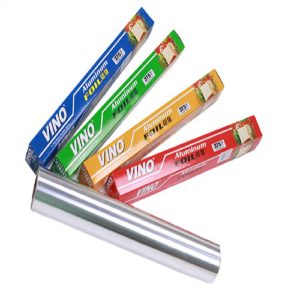مكافحة إغراق رقائق الألومنيوم من الهند
2025-06-23
رقائق الألومنيوم، والمعروفة أيضًا باسم رقائق الألومنيوم في اللغة الإنجليزية البريطانية، هي عبارة عن ورقة رقيقة من المعدن مصنوعة من الألومنيوم.
رقائق الألومنيوم رقيقة للغاية، يتراوح سمكها عادةً بين 0.005 و0.2 مم. وهي مرنة للغاية، ويمكن ثنيها أو طيها أو لفها حول الأشياء بسهولة، مما يجعلها مناسبة لمختلف احتياجات التغليف والتشكيل.
الألومنيوم هو معدن خفيف الوزن، و رقائق الألومنيوم يرث هذه الخاصية، ويضيف وزنًا أقل للعناصر التي يستخدمها معها، وهو أمر مفيد للنقل والتداول.
الألومنيوم النقي غير سام، مما يجعله آمنًا للاستخدام المباشر مع الطعام أو أي أغراض أخرى. كما أنه لا يتسرب منه أي مواد ضارة إلى المحتويات التي يُغلّفها أو يُخزّنها.

في الآونة الأخيرة، اتخذت الحكومة الهندية خطوة جريئة من خلال تنفيذ رسوم مكافحة الإغراق لمدة خمس سنوات على رقائق الألومنيوم من روسيا والصين وتايوان. فُرضت هذه الرسوم في أعقاب اكتشاف ممارسات تجارية غير عادلة من شأنها الإضرار بالصناعات المحلية، وذلك عقب مطالبة صناعة بثق الألومنيوم الهندية بتطبيق تدابير وقائية لحماية الوحدات المحلية غير المستغلة بالكامل من احتمال إغراقها من قِبل دول اتفاقية التجارة الحرة. مع فرض رسوم مكافحة الإغراق للسنوات الخمس المقبلة، إلى أين يتجه قطاع رقائق الألومنيوم الهندي؟
في مارس 2024، أطلقت الهند تحقيقًا بشأن واردات رقائق الألومنيوم من الصين لحماية مصالح الصناعات المحلية. جاء ذلك ردًا على شكوى قدمتها شركات محلية رئيسية، مثل شركة هندالكو، وشركة شيام سيل آند باور المحدودة، وغيرها.
في مارس 2025، فرضت الحكومة الهندية رسومًا مؤقتة لمكافحة الإغراق على واردات رقائق الألومنيوم من الصين، تراوحت قيمتها بين 619 و873 دولارًا أمريكيًا للطن. وفُرضت هذه الرسوم المؤقتة بعد انتهاء التحقيق، مما أدى إلى تدفق رقائق الألومنيوم الصينية منخفضة السعر، مما ألحق أضرارًا مادية بالمنتجين المحليين في الهند.
وفي الوقت الحاضر، فإن إجراءات تطبيق رسوم الإغراق النهائية على رقائق الألومنيوم للسنوات الخمس المقبلة جاءت نتيجة للتحقيق الذي أجرته المديرية العامة للمعالجات التجارية والذي كشف عن تورط روسيا والصين وتايوان في ممارسات تجارية غير عادلة من خلال بيع رقائق الألومنيوم بأسعار أقل، مما ألحق الضرر بالصناعات المحلية.
وتطبق الرسوم الجمركية، التي تتراوح بين 479 و721 دولارا أميركيا للطن، على المنتجات عبر فئات تعريفية متعددة، باستثناء بعض الدرجات الفنية مثل المكثفات ورقائق العزل.
سوق رقائق الألومنيوم في منطقة آسيا والمحيط الهادئ، بما في ذلك الهند
وفقًا لتقرير AL Circle "رقائق الألومنيوم واستخداماتها النهائية - الاتجاهات الحالية والتوقعات حتى عام ٢٠٢٨من المتوقع أن تستحوذ منطقة آسيا والمحيط الهادئ على 15% من إجمالي استخدام رقائق الألومنيوم في العالم بحلول عام 2028، مقارنةً بـ 14% في عام 2023. وبعد أن كانت تتخلف عن أوروبا بنقطتين مئويتين في حصة الاستخدام، من المتوقع الآن أن تلحق بها وتتعادل معها.
من المتوقع أن ينمو الطلب على رقائق الألومنيوم في منطقة آسيا والمحيط الهادئ، التي تشمل اليابان والهند وكوريا الجنوبية وتايلاند وإندونيسيا، بمعدل سنوي متوسط يبلغ حوالي 4% خلال السنوات الخمس المقبلة. وفي الهند تحديدًا، من المتوقع أن ينمو الطلب بنسبة 5.9% تقريبًا خلال هذه الفترة.
واردات الهند من الرقائق المعدنية
الصين هي أكبر منتج ومصدر لرقائق الألومنيوم إلى العالم، بما في ذلك الهند. ورغم انخفاض حجم صادراتها منذ أوائل القرن الحادي والعشرين، إلا أنها لا تزال تتصدر قائمة المصدرين الرئيسيين. في عام 2022، صدّرت الصين 1.46 مليون طن من رقائق الألومنيوم إلى دول العالم، مسجلةً زيادةً بمعدل نمو سنوي مركب بلغ حوالي 8.4% خلال السنوات العشر الماضية. وكانت تايلاند والهند وإندونيسيا والإمارات العربية المتحدة وكوريا الجنوبية والمكسيك والولايات المتحدة الأمريكية والمملكة العربية السعودية من أبرز الدول المستوردة، حيث شكلت هذه الدول مجتمعةً 49% من إجمالي صادرات رقائق الألومنيوم الصينية.
استحوذت الهند وحدها على 8% من الصادرات الصينية، مقارنةً بـ 6% لإندونيسيا والإمارات العربية المتحدة لكل منهما، و5% لكوريا الجنوبية والمكسيك والولايات المتحدة الأمريكية. وبعد عامين، وتحديدًا في عام 2024، ارتفعت صادرات الصين من رقائق الألومنيوم إلى 1.56 مليون طن، مع زيادة حصة الهند إلى 10%، وفقًا لمحللي بنك أوف أمريكا، نقلاً عن بيانات سوق شنغهاي للمعادن. وقد فاقت هذه الزيادة التوقعات المحلية. ففي الأشهر الأحد عشر الأولى من عام 2024، استوردت الهند 140,234 طنًا من الصين، بزيادة قدرها 15.64% مقارنة بالفترة نفسها من العام السابق.
الخطة المستقبلية: إنتاج رقائق الألومنيوم في الهند
- ستنهي شركة هندالكو، الشركة الرائدة في تصنيع الألمنيوم في الهند، الإنتاج الداخلي لرقائق بطاريات الألمنيوم بحلول نهاية أكتوبر 2025، بهدف تقليل الاعتماد على الواردات.
- افتتاح مصنع جديد لرقائق الألومنيوم من قبل شركة SRP Limited في جيتابور، ماديا براديش، يضم أحدث الآلات والمعدات الأوروبية مع التحكم الدقيق في العملية
استخدام الرقائق المعدنية في الهند
في عام ٢٠٢٢، بلغ إجمالي استخدام رقائق الألومنيوم في الهند ٢٨٥ ألف طن، وارتفع إلى ٣٠٠ ألف طن في عام ٢٠٢٣. ومن المتوقع أن يصل استهلاك رقائق الألومنيوم في الهند إلى ٤٠٠ ألف طن بحلول عام ٢٠٢٨، بمعدل نمو سنوي مركب قدره ٥.٩٪. وتشمل القطاعات الرئيسية التي تُسهم في زيادة الطلب: الأغذية والمشروبات، والأدوية، والبلاستيك المُعاد تدويره، ورقائق الألومنيوم المنزلية، وغيرها.

